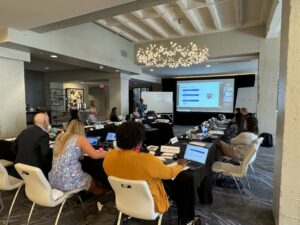
At a July meeting in Minneapolis, ACR
DEI staff lead Michele Andwele worked
with the Nominations & Appointments
Committee on DEI initiatives. (Click to enlarge.)
“While our group carefully considered your application, I regret to inform you that you were not selected this year to serve as a committee volunteer.”
When the email arrived, gently delivering the news that my application to volunteer with the ACR on a committee had not been accepted, my initial reaction was to dismiss it as another testament to the boys’ club mentality. Rather than dwell on the sting of rejection, I resolved to uncover the hidden mechanics behind what seemed like an impenetrable glass ceiling. After all, I had proudly served as ACR’s voice for Rheumatic Disease Awareness Month, actively engaged in the Communications and Marketing Committee, supported RheumPAC, contributed to The Rheumatologist and dutifully advocated on Capitol Hill. What could I possibly offer to bolster my candidacy? What were they looking for? Was I too experienced or not experienced enough?
The list of endless questions prevailed without solace, and I realized that what perpetuated the questions was the lack of transparency and understanding of this all-too-elusive process.
When I received an invitation to join the Nominations & Appointments Committee, my curiosity was further piqued. Here was a chance to peer behind the curtain and to decode the enigmatic process firsthand.
My intent in chronicling this journey is not to critique nor to champion, but to offer an intimate portrayal of its inner workings—a beacon of insight for future aspirants. The experience refers to the committees and the application below for your reference.
Enlightenment
Initially crestfallen by rejection, I found my journey through this intricate process unexpectedly enlightening. Understanding its nuances offers invaluable guidance to future applicants, reassuring them that persistence and thoroughness can turn the tide. Remember, each application is not merely a formality but an opportunity to weave a compelling narrative of dedication and aspiration. I hope that peering behind the curtain allows one to realize that rejection is not personal, and most importantly, it is not permanent.
For those embarking on your own application journey, meticulous preparation and unwavering perseverance are crucial. Your voice is indispensable to the ACR’s mission.
I encourage future applicants to include as much detail as possible in their applications, highlighting the competencies that will distinguish them for their preferred committee. Consider submitting a personal statement or letter of recommendation, especially if it can strengthen your application. This additional information, although not mandatory, provides reviewers with deeper insights into your competencies, interests, voice, goals and skill set.
It’s also beneficial to review each committee’s current roster online (https://rheumatology.org/committees) to gauge the number of vacancies. This insight will help you understand the level of competition and manage your expectations accordingly.
Here is some background information you may find helpful.
Committees & Opportunities
Committees
- Collaborative Initiatives
- Communications and Marketing
- Corporate Relations
- Diversity, Equity & Inclusion (DEI)
- Division Directors
- Education
- Ethics and Conflict of Interest
- Finance
- Global Engagement
- Government Affairs
- Journal Publications
- Pediatric Rheumatology
- Quality of Care
- Registries and Health Information Technology
- Rheumatologic Care
- RheumPAC
- Training
- Workforce Solutions
Application Questions
- Name
- Who are you nominating?
- Is this a self-nomination?
- What abilities and attributes will you bring to the board and/or committee(s) you selected?
- Please explain what interests you about serving on the committee(s) and/or board you selected.
- If you have volunteered for the ACR, Foundation or ARP, list the contributions you made for the committee.
- Please describe any other relevant experience that you believe would be beneficial to volunteer with the College.
- Please list any restrictions on your availability on nights and/or weekends to complete volunteer work.
- Do you feel there is any other information that the Nominations Committee needs to know concerning your nomination?
- Are you a current RISE registry user?
The Selection Process
Appointments to the Committee on Nominations
Members of the Committee on Nominations & Appointments are selected by the ACR Board of Directors. This committee comprises 11 members specifically chosen to represent diverse demographics including, but not limited to, practice setting, area of specialty, career level and region. The committee chair, always the immediate past president, serves a one-year term, and members at large serve two-year terms. The committee includes a member from the ARP, one from the Board of Directors, a fellow in training and a liaison for the DEI (Diversity, Equity & Inclusion) Committee.
All members of the Committee on Nominations & Appointments review all nominations submitted. Each member of the committee is then assigned to focus on two or three specific committees and, from the nominations received, they make recommendations to the full committee. The committee also reviews all nominations for ACR officer and member-at-large positions on the ACR Board of Directors.
Prior to the start of their work, all committee members are oriented to the duties and responsibilities of the committee and the importance of confidentiality. They undergo training on the nominations process and timeline, as well as on the software the ACR uses to manage nominations. They participate in a DEI session that reviews unconscious and implicit biases. All Nominations Committee members disclose any relationships they may have with a candidate and recuse themselves from the discussion and vote, when needed.
Evaluation Process & Criteria
Each Nomination & Appointments committee member engages in discussions with the current committee chairs and staff liaisons of the committees to which they have been assigned to understand the specific competencies and skills demanded by each role. These dialogues illuminate perspectives lost by those rotating off at the end of the year, guiding the search for fresh perspectives and talent. Nominee demographics are taken into consideration, but so are the key skill sets and expertise of members who could be rotating off the committee.
Diversity & Inclusion
A delightful surprise awaited me in the form of a comprehensive snapshot of the demographics of every committee, as well as the nominees, along with a chart illustrating how members rotating off would affect the current demographic balance. This meticulous attention to diversity underscores the ACR’s commitment to ensuring everyone gets a seat at the table. Reviewers are reminded of the critical importance of being aware of our biases throughout the process, fortifying our resolve to judge applications with impartial eyes.
Application Review
Applicants can self-nominate or be nominated by another member of the ACR. The nominations window is from April 1 to June 1 each year. Starting in mid-June, each reviewer assesses the candidates who selected their assigned committee as their first, second or third preference. Responses to the application questions, curriculum vitae and demographic information, as well as any additional materials, such as letters of recommendation or personal statements, are reviewed.
The challenge lies in achieving a balanced alignment with committee needs while shaping a committee that is inclusive of the diversity of voices present across the ACR membership. Reviewers exchange feedback, carefully evaluating each application—an average of two to three reviewers per application—each bringing a discerning eye tailored to their assigned committee’s requirements.
What proved stimulating was realizing that each committee shares universal qualities, such as the need for diverse representation and perspectives, while also possessing specific requirements, like expertise in registries or informatics for the Registries and Health Information Technology Committee. Discussions about committee needs and competencies with current chairs and staff liaisons are invaluable in this regard.
The review process culminates in the creation of a preliminary list of selected members determined by those rotating off the committee. On average, two to three alternates are also preselected and placed in a pool of alternates for committees. For context, there were 159 applicants for a total of 58 positions in 2024. This preliminary list is discussed during the in-person meeting of the Committee on Nominations & Appointments in July.
Decision Making
Imagine an in-person gathering akin to the nail-biting nature of the NBA draft. Although there is no lottery advantage for any committee, some committees are given the opportunity to earn a top pick over others based on the competencies of the members rotating off. The process begins with a pertinent talk led by the ACR’s director of DEI, focusing on identifying unconscious bias. Afterward, the decision-making process commences.
Each reviewer has prepared slide decks that present the needs and competencies of the committees, the gaps identified as current members rotate off and the reviewer’s recommendations of candidates on the preliminary list. Here, spirited debates unfold around the standout contenders for each committee, their profiles brought to life with memorable excerpts from their applications.
The DEI director attends the discussion to help ensure decision making is unbiased. Representatives from the ACR staff serve as the unwavering backbone and hard drive throughout this process. These dedicated staff members are essential for maintaining continuity and efficiency.
The overarching goal is to strategically place applicants to create well-rounded committees that can effectively fulfill their roles within the College. A committee may face a scenario in which all of its private practice members are rotating off in a given year. In such cases, even if an application is outstanding, an individual may not be selected for that committee if they predominantly represent academia, especially if sufficient academicians are already on the current roster. There is also an emphasis on balancing various practice locations and settings within each committee to avoid clustering from just one geographic area, for example.
During these deliberations, reviewers occasionally exchange candidates when better alignment with another committee’s needs is identified. Noteworthy contenders not selected find themselves on an alternate or parking lot list of individuals identified to be recommended for other opportunities on subcommittees or committees with vacancies.
The Committee on Nominations & Appointments chair acts as a democratic and transformational leader, encouraging everyone’s voice and input and ensuring each reviewer has a platform to advocate for applicants. At each step, there is ongoing questioning about how to evolve the process for continuous improvement.
In Sum
When you are considering applying for a volunteer committee appointment, make sure you put your best foot forward. Be thorough in the information you include to demonstrate to the Committee on Nominations & Appointments that your skill set, knowledge, expertise and background align with the needs of the committee(s) to which you are applying. And, if you aren’t selected, don’t give up; there are countless, incredible opportunities to engage with the College.
Remember, as Randy Pausch said in The Last Lecture, “The brick walls are there for a reason. The brick walls are not there to keep us out. The brick walls are there to give us a chance to show how badly we want something.”1
If you have any questions or if you would like to provide feedback on how to improve this process, contact the ACR’s Governance team by email at [email protected].
 Kanika Monga, MD, FACR, is a rheumatologist at Houston Methodist Hospital, Texas. She is also an assistant professor of clinical medicine at Weill Cornell Medical College, New York, and Houston Methodist Academic Institute, and adjunct faculty at Texas A&M University School of Engineering Medicine.
Kanika Monga, MD, FACR, is a rheumatologist at Houston Methodist Hospital, Texas. She is also an assistant professor of clinical medicine at Weill Cornell Medical College, New York, and Houston Methodist Academic Institute, and adjunct faculty at Texas A&M University School of Engineering Medicine.
Reference
- Pausch R, Zaslow J. The Last Lecture. New York: Hyperion; 2008.

